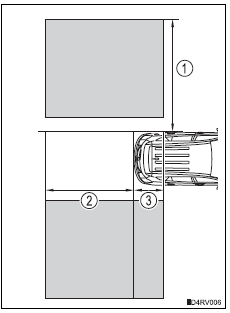Toyota RAV4 (XA40) 2013-2018 Owners Manual: The rear cross traffic alert function
The areas that vehicles can be detected in are outlined below.
The range of the detection area extends to:
- Approximately 11.5 Ft. (3.5 M) from the side of the vehicle
The first 1.6 Ft. (0.5 M) from the side of the vehicle is not in the detection area
- Approximately 9.8 Ft. (3 M) from the rear bumper
- Approximately 3.3 Ft. (1 M) forward of the rear bumper

Caution
Cautions regarding the use of the system
The driver is solely responsible for safe driving. Always drive safely, taking care to observe your surroundings.
The blind spot monitor function is a supplementary function which alerts the driver that a vehicle is present in the blind spot. Do not overly rely on the blind spot monitor function. The function cannot judge if it is safe to change lanes, therefore over reliance could cause an accident resulting in death or serious injury.
According to conditions, the system may not function correctly. Therefore the driver’s own visual confirmation of safety is necessary.
The blind spot monitor function is operational when
- The bsm main switch is set to on
- Vehicle speed is greater than approximately 10 mph (16 km/h).
The blind spot monitor function will detect a vehicle when
- A vehicle in an adjacent lane overtakes your vehicle.
- Another vehicle enters the detection area when it changes lanes.
Conditions under which the blind spot monitor function will not detect a vehicle
The blind spot monitor function is not designed to detect the following types of vehicles and/or objects:
- Small motorcycles, bicycles, pedestrians, etc.*
- Vehicles traveling in the opposite direction
- Guardrails, walls, signs, parked vehicles and similar stationary objects*
- Following vehicles that are in the same lane*
- Vehicles driving 2 lanes across from your vehicle*
*: Depending on conditions, detection of a vehicle and/or object may occur.
Conditions under which the blind spot monitor function may not function correctly
- The blind spot monitor function may not detect vehicles correctly in the following conditions:
- During bad weather such as heavy rain, fog, snow, etc.
- When ice, mud, etc. Is attached to the rear bumper
- When driving on a road surface that is wet due to rain, standing water, etc.
- When there is a significant difference in speed between your vehicle and the vehicle that enters the detection area
- When a vehicle is in the detection area from a stop and remains in the detection area as your vehicle accelerates
- When driving up or down consecutive steep inclines, such as hills, a dip in the road, etc
- When multiple vehicles approach with only a small gap between each vehicle
- When vehicle lanes are wide, and the vehicle in the next lane is too far away from your vehicle
- When the vehicle that enters the detection area is traveling at about the same speed as your vehicle
- When there is a significant difference in height between your vehicle and the vehicle that enters the detection area
- Directly after the bsm main switch is set to on
- When towing a trailer
- When items such as a bicycle carrier are installed on the rear of the vehicle.
- Instances of the blind spot monitor function unnecessarily detecting a vehicle and/or object may increase under the following conditions:
- When there is only a short distance between your vehicle and a guardrail, wall, etc.
- When there is only a short distance between your vehicle and a following vehicle
- When vehicle lanes are narrow and a vehicle driving 2 lanes across from your vehicle enters the detection area
- When items such as a bicycle carrier are installed on the rear of the vehicle
 The blind spot monitor
function
The blind spot monitor
function
The blind spot monitor function uses radar sensors to detect vehicles
that are traveling in an adjacent lane in the area that is not reflected in
the outside rear view mirror (the blind spot), and a ...
 The rear cross traffic alert function
The rear cross traffic alert function
The rear cross traffic alert functions when your vehicle is in reverse.
It can detect other vehicles approaching from the right or left rear of
the vehicle. It uses radar sensors to alert the driv ...
Other materials:
BSM (Blind Spot Monitor)
The Blind Spot Monitor is a
system that uses rear side
radar sensors installed on
the inner side of the rear
bumper on the left and right
side to assist the driver in
confirming safety when
changing lanes.
WARNING
â– Cautions regarding the use of
the system
The driver is solely responsible
for sa ...
Brake front brake flexible hose
Components
Removal
Hint:
Use the same procedures for the lh side and rh side.
The procedures listed below are for the lh side.
Remove front wheel
Drain brake fluid
Notice:
Wash off brake fluid immediately if it comes in
contact with any painted surface.
Remove front flex ...
Before refueling the vehicle
Close all the doors and windows, and turn the engine switch to the
“lock” position (vehicles without a smart key system) or off (vehicles
with a smart key system).
Confirm the type of fuel.
Fuel types
Unleaded gasoline (octane rating 87 [research octane number 91] or
higher)
Cauti ...
